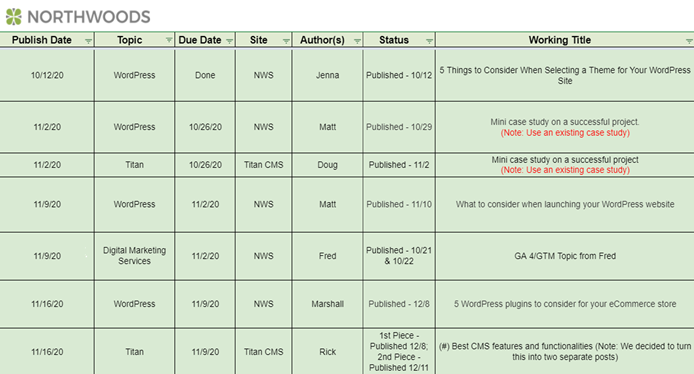By Northwoods Team
April 23, 2021
4 Minute Read
A content calendar, or editorial calendar, shows when and where you plan to publish upcoming content. A content calendar usually includes
- Upcoming pieces
- Topic
- Publication date
- Author(s)
- Ghostwriters
- Working title
- Possible updates to existing content
Here, for example, is a Northwoods content calendar from 2020:

Why Is a Content Calendar Important?
If content is king in a company’s marketing strategy, the kingdom must not fall into chaos. The content calendar organizes production and flow of content and provides an at-a-glance overview of how that content advances both short-term and long-term business goals.
The content calendar:
- Ensures that your content-related tasks are happening and completed.
- Facilitates collaboration and heads off duplication; as employees and/or outside partners team up to create and edit content, it helps to know what everyone in the mix is doing.
- Shows everyone in the business the big picture of upcoming content. Departments beyond marketing – notably sales – can plan to leverage that content.
An organized calendar helps your business keep track of existing content and determine the kinds of content the business will need in the short and long-term future.
Key Elements of a Content Calendar
Editorial
Editorial, the most important element of your content calendar, comprises the pieces of content to be published on your site, social media, or podcast. Advance scheduling and regular publishing are your goals.
There is no right or wrong way to plan your content. Some companies fill their content calendar a whole year in advance; independent bloggers plan perhaps a month out. If you know what’s coming next and when it’s coming, you’re on the right track.
The Platform
The platform is the tool for managing your content schedule. Among the many available tools are:
- Trello
- An editorial plugin for WordPress
- Slack
- Asana
- Loomly
- Microsoft Excel
- Google Calendar
- Google Sheets
Make sure to choose the right platform. The tool that works for a stand-alone blogger might not work for a marketing team of 20. (Imagine the stream of emails from 20 team members inquiring about content statuses.)
Social Media
Posting content only on your website isn’t good enough. Decide what social media platform such as YouTube, Twitter, Facebook, LinkedIn, etc. to share your content. Doing so will increase your brand awareness, engagement, and allow you to reach a bigger audience.
Future Content Ideas
Yes, be organized. But also be flexible.
The digital marketing world changes quickly. A topic that didn’t exist two months ago could be vital today. An unanticipated bright idea could light up a brainstorming session. Be prepared for occasional calendar disruption, or at least amendment.
When you find good ideas that fall outside current plans, write them down. Find spots for them in the content calendar which, after all, is not Holy Writ.
How to Create a Content Calendar
Creating a content calendar may seem daunting at first, however, once you have everything organized, you’ll notice how helpful they really are. Here are steps to creating a content calendar for any platform you choose.
- Make a list of content ideas that best fit your brand persona and niche.
- Choose a publication frequency. Do you want to post content once a day? Once a week? Twice a month? This is where you lay out the specifics of your content strategy.
- Tentatively match your ideas with a medium and distribution platform. Will the editorial piece take the form of a video, a podcast, a blog article? Will you post it on your website, on YouTube? Twitter or Facebook? This can change, but it’s good to think ahead.
- Use the list of content ideas to fill in dates based on your publication frequency.
- Keep an eye on new trends and what your competitors are doing. If you notice something eye-catching, add it to your calendar.
Be creative with your calendar to optimize it for your particular business. At Northwoods, for example, when we publish content, its calendar row turns green. So, the calendar works rather like a multi-pronged progress bar. On any given day, we know exactly where we are.
Why You Need a Content Calendar
A well-thought-out content calendar saves time and energy. It keeps you organized and, most important, it keeps your readers engaged with lively, on-topic, frequently refreshed content.
A content calendar ensures that your message stays in front of prospects, whether that content aims at general branding, at an early conversion (say, filling out a contact form), or at easing a customer deeper into the sales funnel.
Creating content can be fun but keep the fun in “functional.” The content must be relevant, published regularly, and speak in a voice and about topics that align with your company’s overall marketing and branding strategy. A content calendar plays a key role in growing your online presence.
To keep up with the latest digital marketing trends, subscribe to our blog emails. Digital marketing is always changing, and we are here to guide you through it. If you need assistance or answers to questions don’t hesitate to contact us.
Related Blog Posts

Struggling to write unique, high-quality, comprehensive content? Our guide to conducting a content marketing analysis will help you develop content that resonates with your target audience.

Do conversations with your SEO expert about your site's performance leave you with more questions than answers? You're not alone. Check out our SEO field guide to help you navigate through Google's ranking factors.
A list of setup tips for Google Analytics 4 (GA4). Tips cover filters for both hostname and internal traffic; creating custom insights to warn you of low traffic and other anomalies; setting up tracking of search terms entered on your site, etc.